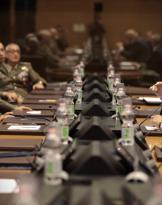The importance of the legal protection of cultural heritage has not only been affirmed at the national level but is a pivotal element of international law that has moved in the direction of the protection of cultural assets especially in armed conflicts, or in those situations that more than others can seriously endanger the life of the asset itself. The same Italian national discipline, to which all military personnel operating in foreign theaters are subjected, is inspired by the ultra-national principles that enter into mass to be part of the law applied to our Armed Forces in an impregnating manner. The recent path traveled by the political leaders of the Defense that move precisely to the specialization of our Forces in the field of the Law is significant cultural heritage.
Brief notes on the subject of international law on armed conflicts
Before going into the examination of international legislation on the protection of artistic heritage, we need to have some basic notions of international law on armed conflicts, now more known as humanitarian law. With the term DIU today we understand both the so-called law of The Hague, and the so-called right of Geneva: the first, concerning the discipline of the use of war violence between the belligerents and the relations between the belligerents and neutral subjects, finds the own source in the Hague Conventions of 1899 and 1907; the second, concerning the protection of victims in armed conflicts and the protection of the civilian population, is represented by the Geneva Convention of 1864, which has been updated by the subsequent contributions with the new Geneva Conventions of 1906, 1929 and 1949. The original dualism of these individual rights (that of the Hague and that of Geneva) has been overcome thanks to the additional Protocols of the 1977 to the four Geneva Conventions as well as to the opinion issued, in the 1996, by the International Court of Justice about the lawfulness of the use of nuclear weapons. In the latter it was noted that the two original branches of international law of armed conflict merged into a single system of law. The international law of armed conflicts does not have a clearly definable origin: we cannot say it is either Eurocentric or attribute its origin to other continents. In all cultures, in fact, rules have developed that tended to regulate conflicts, the only negativity was represented by the inhomogeneous legal context that produced a series of fragmentary norms.
The first treaty on the law of armed conflicts in the modern sense is the 1864 Convention on improving the wounded in the country. Since the beginning of the twentieth century, numerous legislative bodies have followed in this field, above all with the end of the first and second world conflicts, when a strong will developed by all States to regulate the use of force: with the Charter of San Francisco the United Nations Organization has come to form and it has given rise to the elaboration of numerous norms all having, as a common datum, that of wanting to minimize the negative effect of the war.
First the discipline of the use of force in international relations must therefore be examined. Before the League of Nations the war was a means admitted by international law and its methods of execution were regulated by the ius in beautiful. It was not necessary to prove the existence of a legal title to resort to war but this could be declared to protect simple interests being conceived as a means of resolving international disputes. Nevertheless, some self-defense tools different from it were known, such as armed retaliation rather than intervention, or peaceful blockade, but in order to resort to these it was necessary to prove the existence of a legal title. In other words, before the League of Nations there was on the one hand the unlimited possibility of resorting to the instrument of war and on the other a strong limitation, at least on the evidentiary level, in order to resort to alternative instruments. The first impulse towards the tendency to limit the use of armed force is found in the art. 1 of the Hague Conventions of the 1899 and 1907 where the Contracting States agreed to use all the efforts necessary to settle disputes peacefully in order to prevent, as far as possible, the use of armed force in the relationship between States.
As already mentioned, the first source of legislation which strictly limited the use of force for the resolution of disputes between States was the Pact of the League of Nations, concluded in 1919 and entered into force the following year, which it totally excluded war considering it always possible from the moment it was used because of an absolutely prohibitive conduct held by a given State. Subsequently, the 27 August 1928, intervened the Kellogg-Briand pact, also known as the Pact of Paris which, although short - consists of only three articles - has sanctioned the renunciation of war as an instrument of national policy condemning its appeal for the resolution of international disputes. At the end of the Second World War, the 24 October 1945 entered into force the Charter of the United Nations that definitively abolished the possibility of waging war by placing the emphasis not so much on the phenomenon of war as more on the term "force". The general prohibition is in fact to use force in international relations, a prohibition established by art. 2, while placing, art. 51, of exceptions according to the key of legitimate defense. Making a huge leap, therefore regardless of the treatment of how it is possible to use force - and thus leaving out the discussion on the authorizations of the Security Council - we come to the core of this meeting.
It is only with the I Additional Protocol to the Geneva Conventions that it is firmly established that some goods cannot be attacked even in retaliation, and here we find those with cultural value. Article. In fact, 53 reiterates a prohibition already present in the Hague Convention of 14 in May 1954, establishing that monuments and places of worship cannot be attacked as they constitute the cultural and spiritual heritage of peoples. In ratification, then, our country made an interpretative statement stating that these assets will lose the protection granted if they are used illegitimately for military purposes by the enemy.
The historical protection of cultural assets in armed conflicts
The reasonableness that has pushed the international legislator to regulate the protection of the cultural good in the time of war events has been determined by the fact that precisely during the armed conflicts - be they international rather than internal - the risks for their conservation increase significantly. Generally the dangers are those of their damage as a result of military operations as well as their looting or stealing.
The discipline has therefore historically developed precisely in this context. The first rules relating to the protection of cultural heritage were contained in treaties of war law concerning international conflicts and then adapted also to times of peace.
The origins of this legislation can be found in the second half of the nineteenth century, when an international conscience is formed that increasingly moves towards a greater consideration of cultural heritage and its importance for the peoples. It was then held, on the initiative of Tsar Nicholas II of Russia, a first Peace Conference convened in The Hague between the 18 May and the 29 July 1899 which adopted three conventions and three declarations, all international agreements binding for the signatory States, and from the 15 June to the 18 October 1907, the Second Peace Conference was held in The Hague, which, with the intention of renewing the previous legislation, adopted thirteen conventions and a declaration. This, of the Hague Conventions, represents a true codification of international war law. In these conventions, and particularly in the Regulations relating to the laws and customs of the terrestrial war - namely the second Convention of the 1899 and the Fourth Convention of the 1907 - some rules concerning the protection of cultural heritage were expressly laid down.
With particular reference to real estate the art. 27, paragraph 1, Reg. 1907, established the obligation, for States in war, to take every measure necessary to avoid as much as possible the destruction of buildings dedicated to the Arts and Sciences as well as historical monuments on the occasion of sieges or bombings if these buildings were not used for military purposes. These structures were linked to the buildings for Worship or Charitable Works, to hospitals and to any place suitable for the collection of sick and injured. But let us return to the fact of use for military purposes: a corollary arose with regard to the prohibition of using the cultural good for military purposes. The same article, in the paragraph, then included the constraint of identifying cultural assets, buildings and monuments through a distinctive sign in order to facilitate the opposing belligerent party in the task of refraining from carrying out attacks on these assets.
With reference to movable goods, however, the rules of the Hague Conventions - art. 23, paragraph 1, lett. G); Articles. 46, comma 2, and 47 Reg. 1907 - generally forbade the looting of the assaulted or occupied sites. Considering how the period in which these regulatory bodies were developed was strongly characterized by an absolutely liberal ideology, therefore with a strong regard for the protection of private property, the equation carried out by art. 56, Reg. 1907, the assets of the institutions of the Arts and Sciences, owned by the State, the assets of Cult and Benefit Organizations, privately owned. This meant, on the one hand, the prohibition of destruction, of confiscation, of confiscation (except for immediate military necessity), and of looting, and on the other hand the obligation, for the States, to pursue the conduct violating these international provisions. Therefore, these Conventions recognized for the first time in legally binding instruments that even monuments and works of Art and Science, like other cultural heritage, had to be the recipients of special protections during armed conflicts and this recognition was implemented with that which is certainly the most important international instrument for guaranteeing the fulfillment of the obligations undertaken: the responsibility for the violation of established rules. Before the Hague Conferences there had been such directives, as the Brussels Declaration of the 27 August 1874 of theInstitut de Droit International - never adopted - and the Oxford Handbook on the Earth War adopted by the same Institute in 1880, but still remained scientific works, part of a private institution and without legal restrictions for the States. Now, for the first time, the principle of individual responsibility of the author of the violation, later adopted by international law and which today tends to qualify as violations of war certain violations of the rules for the protection of the law, was hypothesised cultural heritage with the consequent criminal repression of the conduct of the individual.
The strong limitation of these Conventions was attributable to their applicability only to wars, or to international armed conflicts between two or more States in which either there had been a formal declaration of war or a concluding behavior of at least one of the parties to the conflict. With the state of war there was the suspension of the application of the norms of international law of peace in favor of international law of war: the war events that were not formally wars were therefore recipients of the norms of international law of peace. The limitations of these Conventions were therefore two: (in primis) the fact that they were applied only in situations of war, and secondly they contained the so-called clause yes omnes that their application was subordinated to the fact that all the warring States were part of the Convention (Article 2, IV Conv. 1907). It was therefore sufficient that only one of the belligerent states had not ratified the Conventions so that they would not be applicable even in the relations between the signatory States party to the conflict.
The Hague Conventions of 1899 and 1907, while representing the first step of the legal binding of the rules for the protection of cultural heritage, can not get my opinion of high positivity because the cultural asset was protected not as such but because compared to other categories of goods, it was therefore not yet recognized as autonomously fundamental. War reprisals were not then prevented, that is, the belligerent was not forbidden to attack a cultural asset in response to a failure, of any kind, of the rules of the war by the adversary.
The Hague Convention of the 1954
Today the most important instrument of international law for the protection of cultural heritage is represented by the Hague Convention of 1954 ratified by Italy following L. 7 February 1958, n. 279. This treaty has a generally universal application as it is open to all states and came to be adopted by a diplomatic conference convened by UNESCO, the United Nations Educational, Scientific and Cultural Organization. This assett normative represents an important element of the evolution of the international law of armed conflicts developed following the Second World War - the four Geneva Conventions of the 1949 - and widens the protection of cultural heritage by filling the gaps in the 1899 and 1907 Conventions. This Convention, ex art. 18, §1 and 2, in fact, finds application not only in the case of war, as properly defined, but in the event of any armed conflict even in the absence of a formal declared state of war and in the case of total or partial occupation of a territory even in the absence of armed resistance (for example, it is also reflected in the Peace Support Operations).
The aforementioned clause yes omnes it is here formally abandoned - in the wake of what has already been done by the Geneva Conventions of the 1949 - without prejudice to the fact that it was already disapplied on the customary level. The Convention finds, therefore, its effects on the Contracting States even in the event that one or more countries involved in the conflict have not taken part.
The most important innovation is still represented by the art. 19 which provides as applicable some provisions related to the protection of cultural assets even in the case of non-international armed conflict, in those situations of internal conflict or non-international armed conflict. The news is of fundamental importance because the risks represented for cultural heritage do not occur only in international conflicts but above all the protection against them is due to internal or mixed conflicts, we think today of the situation represented byIslamic State. In this sense the 1954 Convention appears wider than the subsequent Additional Protocol of the 1977 which provides for a prohibition to commit acts of hostility against historical monuments, works of art and places of worship, but this rule only applies to armed conflicts not that have reached a very high degree of intensity (eg Insurgents have gained control over part of the state's territory). Article. 16 of the Hague Convention of 1954, however, finds its application even within internal armed conflicts and for this reason manifests itself more assured than the subsequent Protocol.
The 1954 Convention represents the first international instrument of universal value that sets up a specific system for the protection of cultural heritage, leaving aside the tendency affirmed by the 1899 and 1907 Conventions of bringing cultural heritage together with other goods worthy of protection such as places of worship and hospitals. In this regard, the ruling contained in the preamble according to which the damage to the cultural property belonging to any people leads to damage to the common heritage of all humanity seems of great importance. This provision is very important already in terms of principles as it explicitly overcomes the traditional nationalistic view of the protection of cultural assets by introducing the notion of the common heritage of humanity for which the protection of cultural heritage is of universal interest and not only of the people to whose specific cultural heritage it could be considered that a particular good belongs.
Equally important is the fact that for the first time in an international treaty the term of cultural good is used and defined (article 1 Conv. 1954) replacing the more restrictive ones previously used (eg Historical monuments, buildings or works of Art and Science). Today with "cultural heritage" are identified for international law, regardless of their public or private nature, movable and immovable property of great importance for the cultural heritage of each people, buildings used as containers of movable property and monumental centers , that is, areas of cultural interest: a concept that is therefore extremely broad and all-encompassing.
Within the aforementioned Convention, in chapters I and II, there is a distinction between general protection and special protection: all the cultural assets that fall within the definition given and which can be, in accordance with art. 6, distinguished by a special distinctive sign. The assets subject to special protection, on the other hand, only those who have been included in a special international register kept by the Director General of UNESCO and which must be distinguished by the distinctive sign (art. 10). At this point we need to focus on this sign. The first element that comes to mind is that, while goods subject to special protection must be distinguished, for other goods there is no need. This provision seems to me not a little strange, in fact instead of guaranteeing the goods subject to special protection a greater guarantee than the one offered to “simple” culinary goods, it lowers the level of protection of the latter by not obliging the States to signal when we are before to one rs World Heritage Site. This distinctive sign, said distinctive marking of cultural propriety, has an international character, therefore it is unique for all and is identified and described in the art. 16: a shield with the apex turned down divided into quadrants by a diagonal cross: the shaded areas are colored in blue, the rest in white. The assets that are the subject of general protection must not then be used for military purposes, therefore for situations suitable for exposing them to destruction or damage in the event of armed conflict. These assets are to be considered immune to any act of hostility directed against them even in retaliation. States are obliged to prevent and prosecute crimes such as theft, looting and any other act of vandalism conducted against such property. An analogous discourse - if anything reinforced - is to be done for the goods covered by special protection that are protected by an addendum to the Convention which is an integral part of it.
I will never tire of pointing out how this Convention clearly states the need for States to prepare themselves in peace time to provide adequate protection of cultural heritage and it is necessary to specify how protection also moves from knowledge: in this context it finds placement of the recent line of the Italian Ministry of Defense which became a pioneer of the project Blue helmets of culture to guarantee a minimum quota for each foreign mission of subjects prepared for the protection of cultural heritage. The didactic work carried out in the university classrooms, like this one, and in the academies as well as in the specialized institutes is fundamental and loudly contributes to the realization of this desire of the international legislator to prepare adequate measures even before a conflict occurs.
At the same time as the 1954 Convention, a Protocol was adopted for the protection of cultural property in the event of armed conflict which, for the first time in a legally binding text, deals with a very important problem: the illicit transfer of movable property in times of conflict. Significant fact is that, unlike the Regulation, this Protocol is not an integral part of the Convention, therefore it assumes the role of a distinct international agreement: not necessarily a State party to the Convention must also be part of this instrument (and it will not therefore be to it bound). This Protocol establishes that, in the case of occupation of a territory by a belligerent country, this has the obligation to prevent the export of cultural goods from the occupied territory and, corollary, the State in whose territory the goods have been illegally imported from an occupied territory, he has the obligation to take them into custody and, at the end of hostilities, he is bound to return them. The occupying State is then required to indemnify the owner of these assets as long as he is in good faith.
Some negative aspects of the 1954 Convention
This Convention, which in any case must be the recipient of a positive judgment, brings with it some critical issues. A first negative aspect that we can observe is that the protection afforded to cultural heritage in times of conflict is not absolute in that it is that of not using cultural assets for military purposes, or the obligation not to commit acts of hostility directed against these it finds explicit derogation in the presence of an imperative military necessity, if the cultural good in question enjoys general protection, or an exceptional case of inevitable military necessity, if the cultural good enjoys special protection (articles 4, §2, and 11 , §2). In the project originally brought to the attention of the UNESCO conference of the 1954 there was no address to the principle of exclusion of the validity of theassett legislation constituting in the case of military necessity, it was in fact a minority expression of States important to want - threatening a failure to adhere to the Convention - the expression of this derogation to the obligations regarding the protection of cultural heritage. The desire to extend the new regulatory data to as many countries as possible, rather than keeping a more rigid but less expected line by the international community, prevailed. However, the fact is not negligible, but it is represented by the fact that, despite this attenuated forecast, these same States either failed to ratify or, as in the case of the United States (2009), have provided for it late. A relevant country that has not yet ratified this Convention is the United Kingdom. However, it is necessary to specify how the bed of the rules put in place to protect cultural assets is in any case part of the customs of international law which, by their very nature, generate obligations towards all states, even those who have refrained from signing the Hague Charter. For this reason, together with the fact that almost all EU member states have signed this document, the same Manual of the Law of Armed Conflict written by the British Ministry of Defense, underlines the importance of being aware of the fundamental principles of the 1954 Convention.
The clause of military necessity remains however a traditional notion of war law taking into account how, each norm of the same, represents the product of a balancing process between the need to respect human rights in conflicts and the need to recognize and wait for the essential military needs. The Convention leaves open space, instead of opting for a more assertive solution like that of specifically identifying prohibited behavior. It forbids tout cour the attack on the cultural good regardless of its illegal use for military purposes by the enemy, but allowing then to waive this prohibition in case of need (Articles 4, 9, 11, §2). In addition to this general derogation, a link is then made between the immunity of the cultural asset and its uselessness for military purposes, but only as regards the goods that enjoy special protection.
With regard to this category of goods, the Convention provides for two exceptions: the first is the already mentioned military necessity - which therefore seems to prevail over any other international need - and which derogates so much from the constraint of non-use of cultural assets for military purposes, as well as to exempt them from attacks (art. 11, §2). In secundis it is envisaged that if a State violates the obligations generated by the Convention, especially the prohibition on the use of cultural property for military purposes, the opposing State may be considered exempt from the obligation to fulfill the immunity guarantee of the property after having, pursuant to 'art. 11, §1, vainly required the cessation of illicit conduct. In this context, the I Additional Protocol of 1977 is placed as normative progress, which, in art. 53, contains the prohibitions of attack of cultural heritage, of use for military purposes and of reprisal regardless of the expression of the military necessity clause which is not referred to.
A second element that friction with the multiple protectionist will of cultural heritage is given by the excessive burden of the criteria necessary for the inclusion of the asset in the International Register of Cultural Heritage subject to special protection. They are specified in the art. 8 of the Convention (while the registration procedure is in the articles 12 and following the Regulation of execution) and it is foreseen how the assets, to be included in the list, must be at a sufficient distance from a large industrial center or any other oblique that can be considered sensitive (for example a communication artery). The special protection does not appear then far superior to the ordinary one in that both in one case and in the other it is foreseen, rightly, the obligation of not using the good for military purposes or making it the object of hostile acts. The only difference is represented by the fact that these constraints, for goods with special protection, come into force from the moment they are registered in the specific Register and can therefore be enjoyed in peacetime. As already stated above, therefore, the difference does not translate, as would be reliable, into greater protection of the assets subject to special protection but in a reduction of protection for assets subject to ordinary protection. A further example is the fact that the preparation of the distinctive sign of the cultural property is an obligation only for those subject to superior protection remaining a burden for others.
Ultimo puntum dolens it is represented by the silence with regard to the specific provision of a responsibility on the part of States for the violation of the provisions of the Convention by merely referring to the current rules of customary international law. Article. 28 of the Convention reinforces certain provisions that already appeared in the previous Treaties of the Hague of 1899 and 1907, placing on States the obligation to prosecute and punish those who have committed - or ordered to commit - an infringement such as that it is the nationality of these. Despite the importance of this norm, its generality remains with respect to the assonants already applicable to war crimes which, unlike the provisions of the 1954 Convention, must necessarily be of a penal nature since the disciplinary one (which instead considers the text of the 1954).
In this context, the I Protocol of the 1977 has provided, in the art. 85, §4, lett. D), that the attack against monuments, works of art and places of worship clearly recognized - therefore under a special protection based on a particular agreement within the framework of a competent international Organization - is a war crime if intentionally committed ( malicious element) and in violation of the legislative decree of the Protocol itself causing serious destruction. In any case, the exemption remains if the damage is collateral to the military operation covered by the principle of necessity. We should therefore interpret that the war crime is solely the direct attack against the cultural assets registered in the International Register under special protection, it would become that those actually protected would be really few. However, it is necessary to specify as the aforementioned article of the 1977 Protocol, in §3, lett. B), considers all indiscriminate attacks launched as international crimes, even knowing the potential risk that these may cause excessive damage to civilian objects (possible fraud). In this sense, art. 3 of the Statute of the International Criminal Tribunal for the former Yugoslavia (Ris. NU 25 May 1993, n. 827) which envisaged, among the behaviors prosecuted by the same Court, violations of the laws and customs of war concerning the capture , the destruction or the damage carried out in a voluntary manner towards institutions dedicated to religion, charity, education, the Arts, Sciences and monuments as well as works of art. The same Tribunal then established how this regulatory provision is applied as much in the context of an international armed conflict as for a non-international armed conflict regardless of its internal or mixed qualification (ICTY, App., Tadic, 2-10-1995). This assumption is characterized by an enormous practical relief, it is enough to point out that the prevailing previous doctrine tended to affirm how to be able to configure an international crime one had to be in a theater of international conflict. This decision by the ICTY Court of Appeal has approached the concept of the cultural good as a heritage of humanity and, as a corollary, has understood that its injury is intrinsically an international crime in accordance with the protected injured legal asset: the capital and the universal interest.
The second Hague Protocol of the 1999
An additional Protocol to the 1954 Convention was adopted at the Hague 26 May 1999. Formally, this is not a substitute for the previous one but more properly an addendum similar to the aforementioned Protocol on the illicit transfer of cultural assets. As regards the issues already dealt with in the Convention, they must be considered in force with respect to the previous ones of the 1954, prevailing, in accordance with the provisions of art. 2 and 4 Prot. 1999, the most recent bond intent.
An important innovation is represented by the fact that, unlike the previous one assett normative that, for the effects of the art. 19 of the 1954 Convention, extended to non-international armed conflicts only the respect of the rules concerning the respect of cultural heritage (art. 4 Conv. 1954), the 1999 Protocol is also applicable to internal armed conflicts but explicitly excludes situations of disorder and internal tension such as riots, isolated and sporadic acts of violence and other similar acts (art. 22 Prot. 1999). About the protection to be guaranteed to cultural heritage, the art. 5 confirms the obligation of the States Parties to assume, already in peacetime, an adequate system of precautionary measures such as the inventory, the planning of fire and collapse emergency measures and the identification of specifications authority for the protection of cultural heritage. With regard to the protection to be assigned in times of armed conflict the second Protocol, not wishing to limit itself to reiterating the obligations pursuant to art. 4 of the 1954 Convention, prepares a series of new constraints to be taken in carrying out military operations to avoid, as much as possible, direct or collateral damage to the assets being protected (articles 7, 8 and 13, §2, letter B) Prot. 1999).
Also in the 1999 Protocol we want to grant a quid pluris of protection to those assets considered of particular interest to humanity: the old privileged protection system gives way to the new program of enchanced protection (enhanced protection) which finds discipline in Chapter III. Again, this regime is applied to those goods contained within a specific List which, unlike the previous Register, is retained by the World Heritage Committee composed of twelve government experts designated for the four-year term by the countries party to the Convention. This body is also entrusted with the task of supervising the implementation of the Protocol. Among the innovations it seems to me significant to report how the same requirements for registration seem clearly more accessible, just think of the development of the necessity clause of adequate distance from an industrial center or from an important military objective.
In point of responsibility it is then necessary to define how Chapter IV provides for an articulated discipline of the responsibility of the individual material author of the violation, and this represents a clear progress with respect to art. 28 of the 1954 Convention. Article. 15 expects that serious violations always constitute criminal offenses to be punished with appropriate penalties by the internal legal systems of the States Parties. The Treaty makes an exhaustive list of criminally relevant conduct, including the attack on a cultural asset, the destruction or appropriation of cultural property, theft, looting and vandalism and, in the case of goods subject to enhanced protection, the use of rs in support of military action. With regard to the other violations of the Protocol such as illicit export, the art. 21 limits itself to binding the States to prepare an adequate sector of legislative, administrative or disciplinary measures for the elimination of such violations.
A privileged treatment issued to the assets subject to enhanced protection is then affirmed in the trial where the art. 16 obliges the signatory countries to adopt effective rules regarding the determination of jurisdiction for serious violations: each State will be able to judge in the event that the violation was committed within its territory or in the event that the author of the same be his citizen. In relation to the crimes of appropriation or destruction and attack of a property subject to enhanced protection, the clause of theaut dedere aut judicare.
The principle of military necessity and the war crime
If so far we have outlined a rigid regulatory framework according to which states must in any case limit the damage to cultural assets, the question we must ask is whether military contingents, and therefore sending states, should always respond whenever a heritage asset is damaged. The answer is certainly negative: if we were to always sanction any damage to cultural heritage we would in fact prevent the proper fulfillment of military needs. The term necessity is not used at random, in fact in the balancing process between the interest in the conservation and integrity of cultural assets, on the one hand, and, on the other, the need to maintain security, two principles have a primary role: proportionality and military necessity.
The military necessity, within the international law of armed conflicts, is certainly recognizable as a logical, ethical and legal prerequisite for the exercise of military force. In fact, the law of war contains a series of rules that can be transgressed in case of military necessity or, as Marazzi already stated, for reasons of war. In this case the strong game is given by the serious and imminent danger for the safety of the people or for the vital interests of the State. The military necessity is therefore considered as a source of legitimization of the generally unlawful conduct in order to ensure the realization of indispensable and prevailing military interests over any other requirement.
Internally, the article 44 cpmp provides that the military who has committed a constituting crime is not punishable for having been forced by the necessity to prevent the mutiny, the revolt, the looting, the devastation, or anyway facts such as to compromise the security of the place, the ship or the aircraft. It therefore appears to be a negligible one of military law although having a general scope and although it is provided for by a special law. The corollary concept that derives from the military necessity is certainly that of proportionality which aims to limit the physiological damage produced by military operations.
The principle of proportionality is contained within the Geneva Convention and the 1949 of the I Additional Protocol to the 1977 concerning the protection of victims of international armed conflicts. It aims to limit the damage caused by military operations by reflecting on the type of use of weapons and methods in waging war. This principle was already established within the norms that preceded the normative body that came into being after the world wars: the first example is provided by the Petersburg Declaration of 1868 in which the legitimate aim of the war, which was to knock out the more men, was exceeded when weapons were used that unnecessarily aggravated the suffering of men put out of action now make it inevitable for them death. Another example is given by the regulation attached to the Fourth Hague Convention of 1907 where it was specified that there was no unlimited right in the choice of the means to harm the enemy and that there was an explicit prohibition of the use of weapons that caused ills superfluous. In general, we can therefore say that the rules protecting both people and property, in dictating limitations on the use of war violence, in the past already obliged commanders to plan every action to ascertain that there was a proportion of military needs , respect for the civilian population, and the not excessive damage to civilian assets.
At this point we need only to frame the definitions of the means and methods. The term means any instrument with which the combatants materially wage war violence against the enemy, while by method we mean every strategic procedure used during the fighting to guarantee the best on the enemy. In this matter we find clearly traces of regulation. The first example is of the 1139. We are during the Second Lateran Council and the use of the crossbow was formally declared unsuitable for a Christian: it is the first example of limitation in the use of a military vehicle. Later we have other examples: in the Law of War and Peace of the great jurist Ugo Grozio, all superfluous bloodshed was forbidden (1625), in the Social Contract of Jean Jacques Rousseau (1762) it was specified how no right authorized to inflict more suffering than how necessary it is to achieve victory.
From all these statements of international law on armed conflicts and from the principle of proportionality, as well as the concept of military advantage, we arrive at the definition contained in the Statute of the International Criminal Court of 2000 of war crime (Art. 8) : anyone who intentionally launches attacks in the knowledge that they will result in the loss of human lives among the civilian population, injuries to civilians or damage to civil property or widespread, lasting and serious damage to the natural environment that are manifestly excessive compared to the whole of concrete and direct military advantages provided.
Having now a more precise picture of the international law on the one hand of protection of Cultural Heritage in the event of armed conflict, and on the other side of what are the international rules that limit and at the same time allow, albeit by limiting it, a military attack on a protected good, we can make a reflection on recent developments.
The cases of Palmyra and religious terrorism of Islamic origin: practical aims of war law aimed at the protection of cultural heritage
The site of Palmyra, in Arabic Tadmur, is located halfway between the Mediterranean Sea and the Euphrates River, and since ancient times it has become a thriving center thanks to its abundant springs and its neutrality compared to Rome and Persia. It has always represented a key point of ancient art: rich in Syro-Anatolian and Hellenic-Roman elements, it was established between the 3rd and 2nd centuries BC and was arranged as an urban agglomeration between the two main buildings: the temple of Bēl and the Efqa source. The subsequent renovations, from the Roman era, were implemented on the sanctuaries and on the streets giving rise to monumental works such as the famous via colonnata.
Since May of this year, this place has fallen under the control of ISIS, the Islamic-jihadist terrorist organization, and has been the subject of numerous damages and destruction, not only, the area of the Roman amphitheater has been used a place of executions: it is here that, in the month of August, the archaeologist Kaled al-Asaad was beheaded, one of the greatest Middle Eastern scholars and responsible for the site of Palmyra for over fifty years. Lastly, so we can hope, newspapers from around the world last October 5 reported about the destruction of the Arc de Triomphe, a two-thousand-year-old artifact.
In light of what we said during the lesson we can then try to answer that question that, quite spontaneously, each of us poses: is it possible to stop the terrorists from these havoc? I usually respond to these that I call "questions about will" with an ancient adage that reads: wanting is power. Having said this, we need to analyze how it is possible to arrest them, or in what way the international law of armed conflicts allows us to operate.
First we need to identify it status agents or terrorists. The first clarification that, in the eyes of the DIU, should be made is that we can in no way find any similarities between the members of the ISIS and the participants of a movement for national liberation, finding the purpose of the affiliates of the Islamic terrorist organization not in the affirmation, at international level, of a State claimed by them based on the principle of self-determination of peoples, but in the destructive will of the world unfaithful to Islam. There are not two profiles, except those of militarily well organized criminal gangs that abuse the use of force in broad contrast with the cardinal principles of international law. They are therefore not deserving of particular protections from the latter and I see no particular reasons that could exclude an armed intervention against them. Besides, this is a line of mine that I have already been able to affirm extensively in other contexts and that here I sketch only for temporal problems, sending you back to reading my contributions left to the magazines of the sector.
Thus affirmed as possible the armed intervention against Islamic terrorists, all that remains is to give legitimacy, in terms of international law, to the use of force. It is governed by the Charter of the United Nations and is admitted only with a defensive character, it is in fact only envisaged in the event that we must defend ourselves against a serious and imminent danger. The honors of the news, surely, do not make us think that every time an armed attack was ordered, from the post-war period to the present, the country that resorted to it experienced that degree of danger recalled by the norms of universal law. Just think of the American attack in Afghanistan, which I do not intend to talk about because we could employ whole lessons, but know that, in a point of legitimacy, it has created many problems and discussions. But today, in my opinion, we are at a different level: if we really want to conceive the cultural good as a heritage of humanity of enormous importance (which it really is) and its damage or destruction as an international crime, then we can glimpse a glow of possibilities for a direct armed intervention for the protection of these goods, meaning that their injury amounts to a serious, concrete, present and huge danger for the survival of conscience and universal identity.
The problem is now linked to the choices of means and methods of combat to avoid those damages that are physiological in the context of an armed conflict. We therefore refer to those principles of proportionality, which I have already mentioned above. Going to the conclusion and leaving to your conscience the answer to the question I just have to give you my personal opinion: I believe that defending cultural heritage is necessary, even with the dagger between the teeth: always remember that those stones, now destroyed, are been laid thousands of years ago by our fellowmen, think of the enormous testimony they represent so placed, think of what they talk about the great ability of man, remember that these assets are among the few traces that remain today of the past civilization, of the our story. Preventing the damage and destruction of cultural heritage is not only a legal duty but a moral obligation of any able-bodied intellect and starts here, from university classrooms, with the realization that not everything can be done to cultural heritage but everything must be done to safeguard them.
DOCUMENTS SUPPORTING THE LESSON
Regulatory documentation cited
Hague Convention of 1899
https://www.admin.ch/opc/it/classified-compilation/18990006/index.html
Hague Convention of 1907
https://www.icrc.org/applic/ihl/ihl.nsf/INTRO/195?OpenDocument
Hague Convention of 1954
http://portal.unesco.org/en/ev.php-URL_ID=13637&URL_DO=DO_TOPIC&URL_SECT...
I Additional Protocol to the Hague Convention of 1954
http://portal.unesco.org/en/ev.php-URL_ID=15391&URL_DO=DO_TOPIC&URL_SECT...
I Additional Protocol to the 1977 Geneva Conventions
www.icrc.org/applic/ihl/ihl.nsf/Treaty.xsp?documentId=D9E6B6264D7723C3C1...
II Additional Protocol to the Hague Convention of 1954
http://portal.unesco.org/en/ev.php-URL_ID=15207&URL_DO=DO_TOPIC&URL_SECT...
Literary contributions cited
ISIS's financial resources and its monetary policy
Online Defense, January 2015
Defense Online, April 2015
How terrorists get commissions for destabilizing actions
Defense Online, June 2015
(photo: Online Defense, images from the Syrian city of Maaloula)











